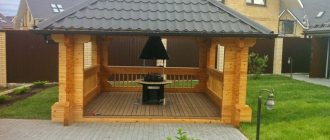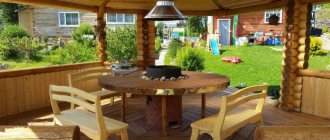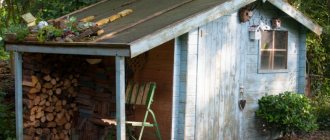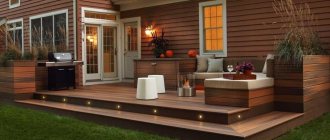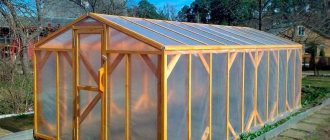Gatherings with guests, dinner with your family in the fresh air, relaxing after work in the garden - an economy class summer gazebo will be very useful to you in any of these situations. It is not always advisable to make it large-scale and spacious; in most cases, a small and budget building is enough, which will delight you and your guests.
Classic sizes of a summer gazebo
The optimal size of a small summer gazebo is 3 by 3 meters. This is enough for both a family circle and a small group of people.
Today's problems sound like this:
- How to build a budget summer gazebo with your own hands?
- What materials can be used to make a summer structure at the lowest cost?
- How much would such construction cost?
This publication will discuss the step-by-step process of constructing, with photos and videos, a small gazebo made of timber with dimensions of 3 by 3 meters. This option is one of the cheapest and most practical for construction, but if for some reason it does not suit you, at the end of the publication I will provide links to similar articles on construction.
The relevance of a homemade gazebo
Before you build a gazebo, you need to find out how relevant it is. The main purpose of the thematic design is protection from precipitation, heat, onlookers and insects.
But the walls and roof can serve other purposes:
- Organization of barbecues in winter and summer;
- An extension to a house to disguise a worn-out facade or protect it;
- Successful completion of the landscape;
- Use as a supporting base for climbing plants;
- Providing children's entertainment.
The secondary purpose of the gazebo influences the choice of its type no less than the main one. For example, for children it is enough to create a small playhouse in the shape of a steam locomotive or a car.
Climbing plants welcome an outdoor wooden pergola, deck or wrought iron equivalent. The presence of a barbecue affects the level of complexity of the foundation and roof.
Moreover, instead of a barbecue, you can use a full-fledged oven (especially if the gazebo is closed and year-round).
Find a suitable location
2d.by
gazebospb.rf
bsmebel.ru
A flat area or a small hill is suitable to protect the foundation from precipitation. It is advisable that this place offers a good view of the surrounding area.
Otherwise, it all depends on your preferences. The gazebo can be either next to the house or in the depths of the garden closer to its border. In the first case, it is convenient to use it as a dining room, in the second - as a place of solitude for quiet rest or reading.
If there is a lot of sun on the site, it is better to place the gazebo in the shade of trees. If the summer is short and not warm, choose an open lawn.
A type of gazebo
In order for the drawings and dimensions of the gazebo to serve as the basis for successful design, the structure itself must correspond to the area of the site.
In particular, we are talking about the ratio of areas and the similarity of styles:
- Firstly, the gazebo should occupy no more than 10% of the total area of the site (the structure can be located anywhere, depending on the specifics of the project);
- Secondly, the thematic shelter must match the residential building and landscape (therefore, for the construction of a gazebo, it is recommended to choose the building materials from which the residential building was built).
On the other hand, the landscape may not resemble the main structure. It is not without reason that for a flowering garden, vineyard and pond one has to choose a pagoda with a curved roof, a wooden pergola and a structure on stilts, respectively.
The relevance of the gazebo allows you to find out the functionality, and the latter, in turn, makes it possible to decide on the following configurations:
- Seasonality – open, semi-open, closed (summer, summer and demi-season, year-round);
- Composition – logs, beams, bricks, boards, forged metal, branches;
- Shape – square, rectangular, polygonal, round, oval;
- Area – small (up to 6 sq.m.), medium (6-10 sq.m.), large (more than 10 sq.m.).
Also, a gazebo for a summer residence can be framed and solid - lightweight and heavy. In the first case, the load-bearing part (frame) is first erected for subsequent finishing. In the second case, the structure is erected in stages (in several rows).
The composition is mainly selected according to the style of the residential building. But if the gazebo will serve only in the warm season, then the consumption of building materials will have to be reduced. In this case, it is not necessary to close window and door openings.
The choice of area is influenced by the number of users. The area and shape are selected depending on the area of the site and the requirements for the style of the finished structure.
Decide on the sizes
Small gazebo 2 × 2 m / prom.st
Medium gazebo 3.5 × 4.5 m / fastbox.su
Large gazebo 6 × 9 m / usadba-dom.ru
First of all, it depends on the number of people who will regularly gather for recreation. It is also important to consider whether the building will include, in addition to a table with chairs, a hammock, barbecue and other equipment.
Gazebos are conventionally divided into three types:
- Small ones (up to 10 m²), designed for 4–6 people, do not include a kitchen area and are more suitable for a family. The optimal size is 3 × 3 m. A more modest option is 2 × 2 m.
- Medium (10–20 m²) - can easily accommodate 10–15 people, that is, the owners and one or two more families of guests. The area allows you to highlight a recreation area and a kitchen. The optimal size is 4 × 4 m or 3 × 5 m.
- Large (over 20 m²) - for noisy companies of 20 or more people. Popular sizes: 5 × 5 m and 6 × 6 m, as well as 5 × 6 m and 5 × 7 m.
The height of the gazebo must be at least 2–2.2 m from the floor to the roof overhang. For large buildings it is worth increasing this parameter, otherwise the appearance will be disproportionate.
Type of foundation for a gazebo
The gazebo can hardly be called a massive structure. However, even this must be built on a foundation.
The load-bearing base is selected depending on the weight of the structure and the complexity of the landscape:
- Columnar brick foundation - suitable for small and medium-sized structures weighing up to 1 ton, welcomes low and medium groundwater levels;
- Pile foundation - suitable for small structures weighing up to 800 kg, serves as a good foundation for any groundwater level and even allows you to build a gazebo over a pond;
- Strip foundation - suitable for light and heavy structures, welcomes any groundwater level, because may include a plinth for utilities;
- Monolithic foundation - similar to a strip foundation and allows you to install the stove both in a corner and along the wall.
The simplest do-it-yourself gazebo made of branches or boards does not put any load on the ground, and therefore can stand on a 10-centimeter drainage pad made of sand and crushed stone.
There is no need to install strip or monolithic foundations under lightweight frame gazebos. Piles or pillars are sufficient. Moreover, red brick or foam concrete are always used for pillars.
Choosing a roof for a gazebo
The shape of the roof is selected depending on the shape of the gazebo. Simple square and rectangular structures have single- and double-pitched roofs. If desired and with an unlimited budget, the structure is completed with a hip or hip roof.
There is also a dome that suits rounded gazebos like a Mediterranean rotunda. Inside such a gazebo there is no fireplace or it is open. Other designs include a chimney that exits through an opening on the side, the center or the roof slope.
In addition to the shape, you will have to choose the roofing material. It is customary to finish the roof of the gazebo:
- Flexible tiles;
- Profiled sheeting;
- Polycarbonate;
- Tarpaulin.
All of these materials have one significant advantage - light weight. They can also be easily and conveniently dismantled.
Wrap the base
It is needed to evenly distribute the load and fasten all the pillars into a monolithic structure.
twoidvor.com
As a rule, a 100 × 100 mm beam is used, which is installed on the pillars through a waterproofing layer. For example, pieces of roofing felt. At the junction points, the timber is sawed down halfway and connected with galvanized (yellow) screws or nails. If there are anchors, the wood is drilled and secured to them using nuts and washers.
To protect wood from rot and insects, treat it with a special compound or old motor oil.
For small gazebos, tying around the perimeter is sufficient. If the length of the building is more than 2 meters, one or more beams are additionally installed in the center.
Step-by-step instructions for building a gazebo
Heavy gazebos include structures made of brick, timber and logs. On the other hand, lumber can be used as load-bearing posts for an outdoor gazebo or a load-bearing frame.
The complexity of constructing a gazebo mainly depends on its seasonality and foundation.
Conventionally, construction can be divided into several stages:
- Drawing a sketch;
- Drawing up a drawing according to the sketch;
- Clearing the area;
- Digging trenches, holes or pits for a specific foundation;
- Directly organizing the foundation - filling the recesses with a drainage layer, installing formwork, reinforcing and filling with cement mortar if necessary;
- Construction of the lower trim;
- Installation of load-bearing vertical pillars or stacking building materials on top of each other;
- Construction of the upper trim;
- Organization of the roofing system - installation of rafters on top of the top frame, fastening of the sheathing, laying of waterproofing and roofing material;
- Wall finishing except for openings for glazing and doors;
- Installation of doors and windows if necessary.
If the gazebo has a barbecue, then the latter will have to be erected before building the walls or frame. An appropriate approach minimizes damage to the structure when carrying bricks, and also allows you to build the kiln itself in good natural light. True, the furnace can be mobile metal.
Make the floor
peredelka.tv
There are several options. The simplest is plank flooring; it is great for wooden buildings and is used most often. You can also make a regular concrete screed or lay paving slabs. These floors are good for pavilions and canopies with a metal frame and solid brick gazebos.
Plank floor
It is convenient to do it immediately after tying, and only then assemble the frame on the boardwalk. To do this, install the logs level with the strapping beams in increments of 50–70 cm and lay the board on top, securing it with nails.
Concrete screed
The floor can be poured both at the start and at the end of construction. Remove the fertile layer of soil and place formwork from boards around the perimeter. Sprinkle the area with a 10–15 cm layer of sand and compact it well. Then lay out 10 cm of crushed stone in a second layer and compact it too. Prepare cement mortar and pour the screed. For strength, you can lay reinforcement mesh inside.
Paving slabs
It can be installed immediately or after completion of work. For installation, first remove the layer of soil. Next, prepare a sand cushion and compact it thoroughly. Then install borders around the perimeter and lay tiles from the corner.
Choosing a stove for a gazebo
A gazebo with a stove is a common occurrence. Moreover, the firebox can be located inside a thematic shelter for several reasons:
- The need to prepare savory dishes;
- Heating the space during the cold season;
- Decorative completion of the interior.
Inside the light open gazebos, the stove is useful only for cooking kebabs. Although even such projects, for fire safety reasons, require the furnace to be remote from the structure.
The question arises, how to make a gazebo with your own hands so that the shelter serves as a kind of kitchen and hearth at any time of the year? First you need to decide on the type of oven:
- Brick - serves as a stationary smokehouse, puts a large load on the foundation, heats up slowly, retains heat for a long time;
- Metal – portable, relatively light weight, heats up and cools down quickly.
For a metal stove, you will have to install a protective screen that will protect the walls from fire and users from burns.
You will also have to take care of installing the chimney. At the exit from the roof, it must be surrounded by a fire-resistant layer so that the roofing material does not ignite. It is desirable that the chimney rises above the highest point of the gazebo.
Otherwise, the thrust for ignition will leave much to be desired. This rule applies to a brick stove, under which, due to the large weight of the firebox, a small additional foundation will have to be erected, i.e. monolithic platform.
Sew up the walls
The final stage of construction is finishing the walls. As a rule, only the lower part is sheathed to the level of the railing, and everything above is left open. There are plenty of options here to suit every taste and budget:
- Lining, block house, OSB boards - wood looks good and additionally holds the structure together.
- Polycarbonate - protects from wind, but allows light to pass through. Easy to install.
- The corrugated sheet is a solid wall, provides shade and protects from the wind.
- Decorative grille - suitable for both the lower and upper parts of the walls.
- Climbing plants - a dense hedge will protect from the sun and rain no worse than solid walls, and at the same time it looks more pleasant.
- Leave it as is - the design will be well ventilated and look very elegant.
